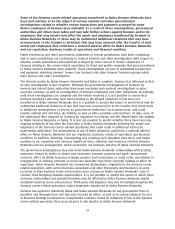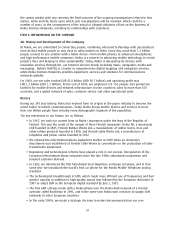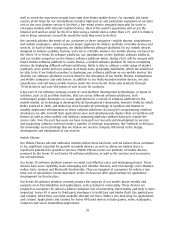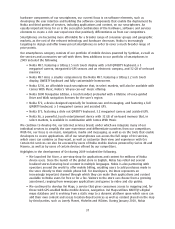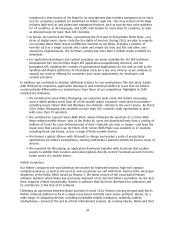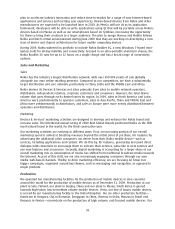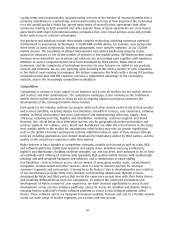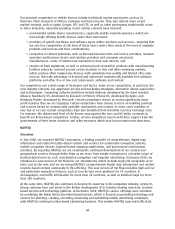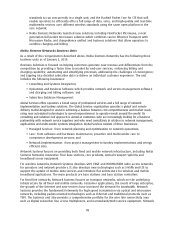Nokia 2009 Annual Report Download - page 43
Download and view the complete annual report
Please find page 43 of the 2009 Nokia annual report below. You can navigate through the pages in the report by either clicking on the pages listed below, or by using the keyword search tool below to find specific information within the annual report.products, services, platforms and technologies, our corporate research center creates assets and
competencies in technology areas that we believe will be vital to our future success. In recent years,
Nokia Research Center has been a contributor to almost half of Nokia’s standard essential patents.
The center works closely with Nokia Devices & Services and Nokia Siemens Networks and collaborates
with several universities and research institutes around the globe. These include the Massachusetts
Institute of Technology (MIT), Stanford University, the University of California, Berkeley and the
University Southern California (USC) in the United States; Cambridge University in the United Kingdom;
Ecole Polytechnique Federale de Lausanne (EPFL) and Eidgeno
¨ssische Technische Hochschule Zu
¨rich
(ETHZ) in Switzerland; Aalto University, Tampere University of Technology and University of Tampere in
Finland; and Tsinghua University and the Beijing University of Post and Telecommunication (BUPT) in
China.
Nokia Research Center’s research agenda is focused on four core areas:
• Rich Context Modeling—Interactions between people and their surroundings, location, and
social environment provide the basis for new classes of services in areas such as traffic, health
and entertainment, enabling new business models to emerge.
• New User Interface—Future user interfaces will utilize intelligence and contextawareness to
enhance user experiences, integrating the personalized and adaptive aspects of devices with
datasharing capabilities.
• High Performance Mobile Platforms—Research focuses on improving the performancetopower
ratio, delivering new sensing capabilities as well as extending platform architecture to enable
interoperability and facilitate application development.
• Cognitive Radio—Research in this area examines ways to utilize wireless spectrum dynamically
to improve connectivity and capacity and enable largescale sensing.
One research project at Nokia Research Center is ’Morph’, a concept that demonstrates the
functionality that nanotechnology might be capable of delivering: fully flexible materials, a
revolutionary selfcleaning shell and transparent electronics. Every element of the Morph concept
represents individual areas already being researched by Nokia Research Center, together with the
Cambridge Nanoscience Centre.
Another research project at Nokia Research Center is ’CommunityEnhanced Traffic’. This project,
formerly known as ’Traffic Works’, has seen Nokia Research Center’s Palo Alto laboratory in California
combine its research efforts with the University of California, Berkeley’s California Center for
Innovative Transportation, to study how best to collect realtime traffic flow data from GPSenabled
mobile devices while protecting the users’ privacy. Building on the Ovi Maps service available today,
this provides a glimpse into the future with the mobile device as a personal travel assistant.
Strategic Sourcing and Partnering
In line with industry practice, Devices & Services sources components for our mobile devices from a
global network of suppliers. Those components include electronic components, such as chipsets,
integrated circuits, microprocessors, standard components, printed wiring boards, sensors, memory
devices, cameras, audio components, displays, batteries and chargers, and mechanical components,
such as covers, connectors, key mats, antennas and mechanisms. Such hardware components account
for the majority of our overall spending on sourcing.
We source chipsets from four different commercial suppliers: Broadcom, Infineon Technologies,
Qualcomm and STEricsson. We discontinued our own chipset development in 2007. Our multivendor
strategy is aimed at increasing the efficiency of our research and development efforts by allowing
Nokia to leverage external innovation through working with the best partner in a specific chipset
development area, and by freeing our own R&D resources to focus on our core competencies in
modem development and other areas central to Nokia’s growth strategy, such as services.
41


